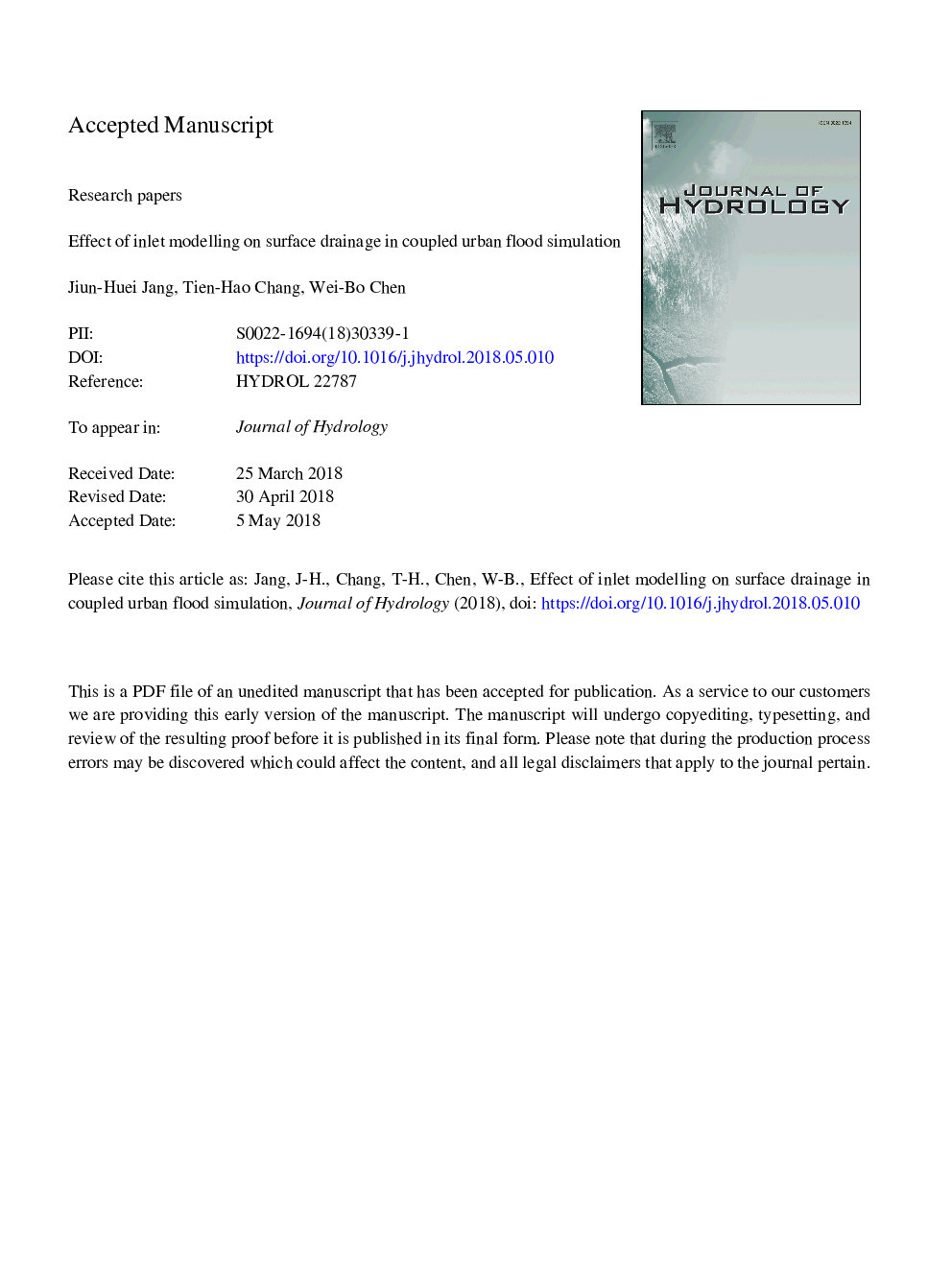| کد مقاله | کد نشریه | سال انتشار | مقاله انگلیسی | نسخه تمام متن |
|---|---|---|---|---|
| 8894654 | 1629892 | 2018 | 38 صفحه PDF | دانلود رایگان |
عنوان انگلیسی مقاله ISI
Effect of inlet modelling on surface drainage in coupled urban flood simulation
ترجمه فارسی عنوان
تأثیر مدل سازی ورودی بر روی زهکشی سطحی در شبیهسازی سیلاب شهری
دانلود مقاله + سفارش ترجمه
دانلود مقاله ISI انگلیسی
رایگان برای ایرانیان
کلمات کلیدی
شبیه سازی سیل، مدل همپوشانی، فاضلاب زه کشی، شهری، نفوذ،
ترجمه چکیده
برای یک منطقه بسیار توسعه یافته شهری با سیستم های زهکشی کامل، شبیه سازی سیل برای توصیف پویایی جریان از بارش، رواناب سطح و جریان فاضلاب ضروری است. در این مطالعه، یک مدل سیل تلفیقی بر مبنای معادلات موج دیفرانسیل ارائه شده است تا به طور همزمان شبکۀ فاضلاب یک بعدی و جریان دو بعدی آن را شبیه سازی کند. مدل جریان جغرافیایی جزئیات مربوط به روند بارش باران را برای تخمین رواناب اضافی که در سیستم فاضلاب از طریق ورودی خیابان برای مسیر جریان فاضلاب وارد می شود، فراهم می کند. سه نوع مدل سازی ورودی در این مطالعه در نظر گرفته شده است، از جمله روش مبتنی بر انفجار که ورودی های خیابانی را از طریق تخلیه آب های سطحی به طور مستقیم به سوراخ های دریایی، و روش ورودی انفجاری که آب سطحی را به دریچه هایی که هر یک به ورودی های چندگانه متصل است، رویکرد گره ورودی که آب سطحی را به گره های فاضلاب که به ورودی های فرد متصل هستند تخلیه می کند. نتایج شبیه سازی با یک رویداد بارش باران با شدت بالا که در سال 2015 در شهر تایپه اتفاق افتاد مقایسه شد. در بررسی میزان حداکثر سیلاب، دو رویکردی که ورودی خیابان ها را در نظر گرفته اند، به طور قابل توجهی بهتر از آن است که بدون ورودی خیابان انجام می شود. با توجه به مدل های فوق از لحاظ تغییرات سیل زمانی، استفاده از لولاهای به عنوان گیرنده منجر به تخلیه ناکارآمد کلی از آب های سطحی یا به وسیله روش مبتنی بر انفجار یا روش ورودی دریچه می شود. با استفاده از رویکرد گره ورودی، معقولتر از استفاده از رویکرد ورودی دریچه است، زیرا رویکرد گره ورودی به طور چشمگیری نوسانات سطح آب فاضلاب را کاهش می دهد. رویکرد ورودی گره در تخلیه آب های سطحی با کاهش حجم سیلاب ها در مقایسه با روش ورودی دریچه و در مقایسه با روش مبتنی بر انفجار 41 درصد بیشتر است. نتایج نشان می دهد که مدل سازی ورودی تأثیر قابل توجهی بر کارایی زهکشی در شبیه سازی سیلاب دارد.
موضوعات مرتبط
مهندسی و علوم پایه
علوم زمین و سیارات
فرآیندهای سطح زمین
چکیده انگلیسی
For a highly developed urban area with complete drainage systems, flood simulation is necessary for describing the flow dynamics from rainfall, to surface runoff, and to sewer flow. In this study, a coupled flood model based on diffusion wave equations was proposed to simulate one-dimensional sewer flow and two-dimensional overland flow simultaneously. The overland flow model provides details on the rainfall-runoff process to estimate the excess runoff that enters the sewer system through street inlets for sewer flow routing. Three types of inlet modelling are considered in this study, including the manhole-based approach that ignores the street inlets by draining surface water directly into manholes, the inlet-manhole approach that drains surface water into manholes that are each connected to multiple inlets, and the inlet-node approach that drains surface water into sewer nodes that are connected to individual inlets. The simulation results were compared with a high-intensity rainstorm event that occurred in 2015 in Taipei City. In the verification of the maximum flood extent, the two approaches that considered street inlets performed considerably better than that without street inlets. When considering the aforementioned models in terms of temporal flood variation, using manholes as receivers leads to an overall inefficient draining of the surface water either by the manhole-based approach or by the inlet-manhole approach. Using the inlet-node approach is more reasonable than using the inlet-manhole approach because the inlet-node approach greatly reduces the fluctuation of the sewer water level. The inlet-node approach is more efficient in draining surface water by reducing flood volume by 13% compared with the inlet-manhole approach and by 41% compared with the manhole-based approach. The results show that inlet modeling has a strong influence on drainage efficiency in coupled flood simulation.
ناشر
Database: Elsevier - ScienceDirect (ساینس دایرکت)
Journal: Journal of Hydrology - Volume 562, July 2018, Pages 168-180
Journal: Journal of Hydrology - Volume 562, July 2018, Pages 168-180
نویسندگان
Jiun-Huei Jang, Tien-Hao Chang, Wei-Bo Chen,
